| Listing 1 - 10 of 42 | << page >> |
Sort by
|
Book
ISBN: 1573314579 1573314560 Year: 2003 Publisher: New York (N.Y.) New York academy of sciences
Abstract | Keywords | Export | Availability | Bookmark
 Loading...
Loading...Choose an application
- Reference Manager
- EndNote
- RefWorks (Direct export to RefWorks)
Biochemistry --- Chemistry --- Philosophy --- Physical sciences --- Biological chemistry --- Chemical composition of organisms --- Organisms --- Physiological chemistry --- Biology --- Medical sciences --- Composition
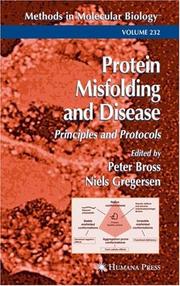
ISBN: 1280842695 9786610842698 1592593941 1588290654 Year: 2003 Publisher: Totowa, NJ : Humana Press : Imprint: Humana,
Abstract | Keywords | Export | Availability | Bookmark
 Loading...
Loading...Choose an application
- Reference Manager
- EndNote
- RefWorks (Direct export to RefWorks)
It has now become clear that a large number of diseases with very different pathologies share a common framework of protein misfolding, accompanied by degradation and/or aggregation of the misfolded proteins. In Protein Misfolding and Disease: Principles and Protocols, notable experts in conformational disease review the latest thinking about the molecular processes underlying these diseases and describe cutting-edge biochemical, genomic, cellular, and chemical laboratory techniques for studying their genesis and pathologies. The authors apply their carefully refined methods to a variety of metabolic and neurodegenerative disorders, as well as to the aging process. The techniques presented are broadly applicable in many diverse disease contexts and may be used in both diagnosis and detailed research on new treatment strategies. Each tried and proven protocol includes insightful background notes, lists of required equipment and reagents, step-by-step instructions, and tips on troubleshooting and on how to avoid known pitfalls. Comprehensive and cutting-edge, Protein Misfolding and Disease: Principles and Protocols offers both novice and experienced researchers a solid theoretical grounding in conformational disease and a remarkable set of analytical methodologies for uncovering its characteristics and generating new therapeutic approaches.
Biochemistry. --- Biochemistry, general. --- Biological chemistry --- Chemical composition of organisms --- Organisms --- Physiological chemistry --- Biology --- Chemistry --- Medical sciences --- Composition
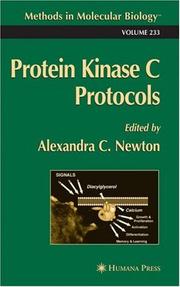
ISBN: 1280842717 9786610842711 1592593976 1588290689 Year: 2003 Publisher: Totowa, NJ : Humana Press : Imprint: Humana,
Abstract | Keywords | Export | Availability | Bookmark
 Loading...
Loading...Choose an application
- Reference Manager
- EndNote
- RefWorks (Direct export to RefWorks)
Protein kinase C impacts on nearly every aspect of signal transduction, placing it at the forefront of research in how cells transduce information. In Protein Kinase C Protocols, leading investigators from academia and industry present a comprehensive collection of classical and emerging laboratory techniques for the study of this influential protein, all optimized for successful and reproducible results. Described in step-by-step detail, these methods can be easily used to explore the structure, function, regulation, subcellular localization, and macromolecular interactions of protein kinase C. Included in this collection are easy-to-follow techniques to purify protein kinase C, to measure its activity and its membrane interaction in vivo and in vitro, and to identify substrates. There are also methodologies and techniques for measuring the phosphorylation state of protein kinase C, for expressing and analyzing the membrane-targeting domains of protein kinase C, and for detecting binding proteins. Additional chapters address pharmacological probes, genetic approaches, and protein kinase C in disease. Each protocol is introduced in the context of protein kinase C function and regulation and contains many notes on how best to deal with the problems that may occur. Comprehensive and authoritative, Protein Kinase C Protocols offers a timely compilation of biophysical, biochemical, cell biological, and molecular biological approaches that will ensure successful results in every laboratory working in this rapidly advancing field.
Biochemistry. --- Biochemistry, general. --- Biological chemistry --- Chemical composition of organisms --- Organisms --- Physiological chemistry --- Biology --- Chemistry --- Medical sciences --- Composition
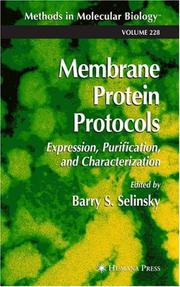
ISBN: 1280843241 9786610843244 159259400X 1588291243 Year: 2003 Publisher: Totowa, NJ : Humana Press : Imprint: Humana,
Abstract | Keywords | Export | Availability | Bookmark
 Loading...
Loading...Choose an application
- Reference Manager
- EndNote
- RefWorks (Direct export to RefWorks)
Recent developments in molecular biology and biochemistry have made it possible to determine the three-dimensional structure of membrane proteins and so come to a full understanding of their function. In Membrane Protein Protocols: Expression, Purification, and Characterization, researchers at major universities and research centers around the world describe in detail the key techniques that have proven successful in the study of receptors and transport proteins. The book provides examples of how different membrane proteins can be overexpressed in both prokaryotic and eukaryotic expression systems, how natural and overexpressed proteins can be solubilized from their host membranes, and how the solubilized protein can be purified in active form. Each protocol contains step-by-step instructions to ensure success, troubleshooting advice, lists of reagents, and tips on avoiding pitfalls. Timely and highly practical, Membrane Protein Protocols: Expression, Purification, and Characterization offers investigators proven methods to determine the three-dimensional structure of membrane receptors and transport proteins, as well as proven practical help in the discovery of new clinical targets for the design of novel pharmaceutical agents useful in treating cancer, bacterial and viral infection, and many metabolic diseases.
Biochemistry. --- Biochemistry, general. --- Biological chemistry --- Chemical composition of organisms --- Organisms --- Physiological chemistry --- Biology --- Chemistry --- Medical sciences --- Composition
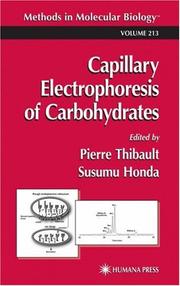
ISBN: 1280830778 9786610830770 1592592945 0896038262 Year: 2003 Publisher: Totowa, NJ : Humana Press : Imprint: Humana,
Abstract | Keywords | Export | Availability | Bookmark
 Loading...
Loading...Choose an application
- Reference Manager
- EndNote
- RefWorks (Direct export to RefWorks)
Recent developments in high-resolution separation techniques based on capillary-scale chromatography and electrophoresis have transformed the analysis of free and conjugated mono- and oligosaccharides. In Capillary Electrophoresis of Carbohydrates, hands-on experts describe cutting-edge techniques in capillary electrophoresis (CE) for the analysis of complex carbohydrates. Written in step-by-step detail to ensure successful experimental results, these readily reproducible protocols provide methods for sample preparation and analysis of mono- and oligosaccharides, glycoproteins, and glycoconjugates. Different CE separation formats, including capillary zone electrophoresis (CZE), capillary isoelectric focusing (CIEF), capillary isotachophoresis (CITP), capillary gel electrophoresis (CGE), and micellar electrokinetic chromatography (MEKC), are presented for different types of applications, such as the analysis of glycoforms, the separation of enantiomers, and the resolution of oligosaccharides. The separation of native derivatized carbohydrates is presented using UV, fluorescence, and mass spectrometric detection. Two other applications demonstrate the use of CE as an assay method for monitoring glycosyltransferase activity and for determining the association constant of carbohydrate-protein interaction. A useful appendix describes the structures of the most commonly encountered carbohydrate residues and oligosaccharides from mammalian and bacterial origins. Each protocol contains detailed information on reagents, apparatus, and valuable comments and notes on methods. Timely and highly practical, Capillary Electrophoresis of Carbohydrates provides both novice and experienced CE analysts with powerful tools for the successful separation of complex carbohydrates by capillary electrophoresis.
Biochemistry. --- Carbohydrates. --- Biochemistry, general. --- Carbohydrate Chemistry. --- Carbs (Carbohydrates) --- Biomolecules --- Organic compounds --- Glycomics --- Biological chemistry --- Chemical composition of organisms --- Organisms --- Physiological chemistry --- Biology --- Chemistry --- Medical sciences --- Composition
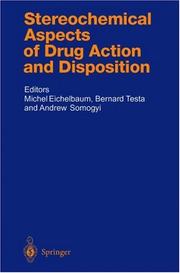
ISBN: 3540415939 3642625754 3642558429 Year: 2003 Volume: 153 Publisher: Berlin : Springer,
Abstract | Keywords | Export | Availability | Bookmark
 Loading...
Loading...Choose an application
- Reference Manager
- EndNote
- RefWorks (Direct export to RefWorks)
Pharmacology. --- Pharmacy. --- Biochemistry. --- Pharmacology/Toxicology. --- Biochemistry, general. --- Biological chemistry --- Chemical composition of organisms --- Organisms --- Physiological chemistry --- Biology --- Chemistry --- Medical sciences --- Medicine --- Drugs --- Materia medica --- Pharmacology --- Drug effects --- Medical pharmacology --- Chemicals --- Chemotherapy --- Pharmacy --- Composition --- Physiological effect
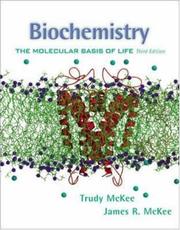
ISBN: 007231592X 9780072315929 Year: 2003 Publisher: New York (N.Y.): McGraw-Hill
Abstract | Keywords | Export | Availability | Bookmark
 Loading...
Loading...Choose an application
- Reference Manager
- EndNote
- RefWorks (Direct export to RefWorks)
Biochemistry --- 577 --- Biological chemistry --- Chemical composition of organisms --- Organisms --- Physiological chemistry --- Biology --- Chemistry --- Medical sciences --- Material bases of life. Biochemistry. Molecular biology. Biophysics --- Composition --- Biochemistry. --- 577 Material bases of life. Biochemistry. Molecular biology. Biophysics
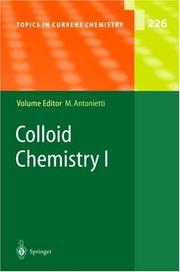
ISSN: 03401022 ISBN: 3540004157 3540364080 9783540004158 Year: 2003 Volume: 226 Publisher: Berlin Springer
Abstract | Keywords | Export | Availability | Bookmark
 Loading...
Loading...Choose an application
- Reference Manager
- EndNote
- RefWorks (Direct export to RefWorks)
Organic chemistry. --- Polymers . --- Biochemistry. --- Organic Chemistry. --- Polymer Sciences. --- Biochemistry, general. --- Biological chemistry --- Chemical composition of organisms --- Organisms --- Physiological chemistry --- Biology --- Chemistry --- Medical sciences --- Polymere --- Polymeride --- Polymers and polymerization --- Macromolecules --- Organic chemistry --- Composition
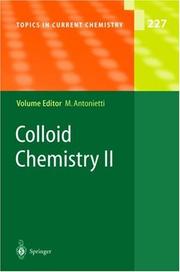
ISSN: 03401022 ISBN: 3540004181 3540364129 9783540004189 Year: 2003 Volume: 227 Publisher: Berlin Springer
Abstract | Keywords | Export | Availability | Bookmark
 Loading...
Loading...Choose an application
- Reference Manager
- EndNote
- RefWorks (Direct export to RefWorks)
Over the past forty years,good-old fashioned colloid chemistry has undergone something of a revolution,transforming itself from little more than a collection of qualitative observations of the macroscopic behavior of some complex systems into a discipline with a solid theoretical foundation and a whole to- boxofnew chemical techniques. It can now boast a set of concepts which go a long way towards providing an understanding of the many strange and interesting behavior patterns exhibited by natural and artificial systems on the mesoscale. This second volume of“Topics in Current Chemistry”on Colloid Chemistry, focuses on supramolecular approaches and new approaches towards polymer colloids,also with strong emphasis on biological and biomedical applications. Again topics were chosen which are expected to have broader relevance and to be interesting to a more general readership. The volume opens with a contribution by C.M.Paleos in which new amp- philes are presented which not only self-assemble to micelles or vesicles but also possess the ability to show specific recognition of complementary H-bridge p- terns.Such structures might point a way to a rational addressing of surfaces and supramolecular structures by purely chemical means.
Organic chemistry. --- Polymers . --- Biochemistry. --- Organic Chemistry. --- Polymer Sciences. --- Biochemistry, general. --- Biological chemistry --- Chemical composition of organisms --- Organisms --- Physiological chemistry --- Biology --- Chemistry --- Medical sciences --- Polymere --- Polymeride --- Polymers and polymerization --- Macromolecules --- Organic chemistry --- Composition
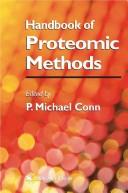
ISBN: 1588293408 1617375047 9786610843251 159259414X 128084325X 9781588293404 Year: 2003 Publisher: Totowa, N.J. Humana Press
Abstract | Keywords | Export | Availability | Bookmark
 Loading...
Loading...Choose an application
- Reference Manager
- EndNote
- RefWorks (Direct export to RefWorks)
The developing new field of proteomics holds significant promise for a deeper understanding of complicated biological systems, as well as for novel approaches to the cure of disease. In the Handbook of Proteomic Methods, P. Michael Conn has assembled a panel of well-recognized experts to describe a wide range of powerful techniques for identifying and analyzing the diversity of proteins expressed in cells. These readily reproducible proteomic methods range from general to specific techniques, and include methods for data analysis, post-translational modification, and its variants and isoforms. Additional methods demonstrate the application of proteomics to the discovery of serological tumor markers, to identifying the determinants of sensitivity to antitumor drugs, and to specialized fields, such as endocrinology, plant biology, nephrology, and urology. Each fully tested protocol is described in step-by-step detail, complete with tricks of the trade and hints on avoiding pitfalls. The detail of description exceeds that usually found in primary publications. Wide-ranging and practical, the Handbook of Proteomic Methods offers scientists entering, or already active in, the field a fully referenced compendium of easy-to-use proteomic methods-each reflecting the power and promise of proteomics in illuminating complex biological systems and in promoting the development of novel drugs for the amelioration of disease.
Analytical biochemistry --- Proteomics --- Biochemistry --- Genomics --- Computational Biology --- Biological Science Disciplines --- Genetics --- Chemistry --- Biology --- Natural Science Disciplines --- Disciplines and Occupations --- Human Anatomy & Physiology --- Health & Biological Sciences --- Animal Biochemistry --- Biochemistry. --- Biochemistry, general. --- Biological chemistry --- Chemical composition of organisms --- Organisms --- Physiological chemistry --- Medical sciences --- Composition --- Molecular biology --- Proteins
| Listing 1 - 10 of 42 | << page >> |
Sort by
|

 Search
Search Feedback
Feedback About
About Help
Help News
News